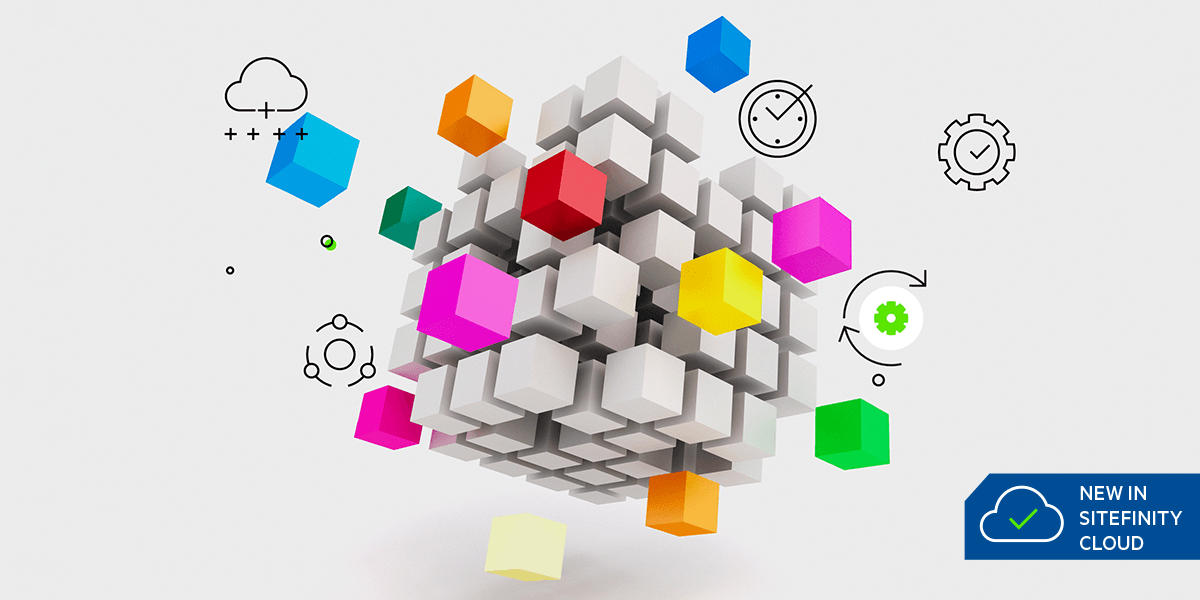Space Jam: Blob Storage in Sitefinity Cloud

Don’t let your database size get out of hand. Draw a line between media and content. Enjoy a new level of agility with faster, more convenient backups and restores. The new Sitefinity Cloud add-on leverages Azure Blob Storage and is fully configured to click with all your environments and CI/CD pipelines. Ready when you are.
Media in Blob. Content in DB. Environments in Sync
So, here’s the deal. Sitefinity Cloud customers have the option to choose blob storage over database for their media files and documents. Because it’s optimized for storing massive amounts of unstructured data, external blob is the obvious answer if you’re managing loads of imagery and videos.
If you go for the external storage option, you get 1TB in a dedicated account. Now, since you’re most likely using the advanced CI/CD capabilities of Sitefinity Cloud and have more than one environment, you get a dedicated blob container for each of your environments. That’s right, the total worth of 1TB is split between containers but that’s enough space still for even a media-heavy project. Of course, you have the option to upgrade your storage if and when you need to.
Separate containers are key to problem-free continuous delivery as potential blob storage conflicts between environments are all but ruled out. Your account and the dedicated storage containers are fully provisioned by the Sitefinity Cloud Team, with blob sync configured every step of the code and content flow.
Content Flow and Blob Sync Across Environments
Blob sync has been integrated into the routine backup and restore operations you use in your development and code promotion flow. The diagram below illustrates the entire workflow. Note that it’s based on the most complex setup possible—one with a content staging environment and a content pipeline, which is another Sitefinity Cloud add-on.

So, whether you’re synchronizing databases between your dev, staging and production environments prior to or after a successful code deployment, the blob containers in each environment are synced along as well. The same is true with a content staging environment (if you have one)—technically, the only difference is that SiteSync has blob sync support right out of the box.
The blob sync that takes place during DB backup and restore is based on the Microsoft AzCopy functionality. What this script, designed specifically for blob sync, does is compare timestamps to move files from the source to the destination. There’s a Delete Destination option you can control manually, which essentially lets you decide whether to keep or delete files in the destination. It’s set to True by default, but you would want it set to False during DB restore to Dev for example. You don’t want to delete other people’s files—if multiple developers are working on the same dev environment.
Last but not least, the Sitefinity Cloud Engineering has seen to it that blob storage and the Multi-region Failover add-on don’t stand in each other’s way. The failover region has been configured to use the Production storage container, making sure your media libraries are safe and available in case of a disaster recovery.
1TB of External Media Storage: Don’t Pass on a Great PaaS Add-on
Sitefinity Cloud is superbly configured for the ultimate performance and reliability, which we all have every reason to expect from a proper platform-as-a-service. You have the infrastructure and services in place to go out there and be productive, but it's important to understand and use all the platform’s capabilities to your best advantage.
The External Media Storage Add-on is another handy tool, next to CDN for entire pages, the built-in CI/CD for code and the secure and reliable content pipeline. Think of it as another piece of the puzzle. A small piece indeed, but one that can fit right in and make a big difference for a platform built for scalability and coherent collaboration.
To sum it all up, here’s what you’re getting:
- Reduced database size
- Separation of assets (media and files) from content
- Fast and convenient DB backups and restores
- Dedicated containers for each environment you’re running
- Fully integrated with the CI/CD pipelines
The Sitefinity Cloud 1TB of External Media Storage add-on is available for all license tiers and can be topped with an extra 1TB if needed. Explore the Sitefinity Cloud Tiers for details and get in touch with your Sitefinity Cloud rep today. Check out the Sitefinity Cloud Blob Storage documentation for a closer look at the technical specs. Once you opt for the add-on, there’s nothing else you need to do other than select the new storage provider for the libraries you choose to move. Everything else is fully provisioned by the Sitefinity Cloud team. Ready when you are, indeed.
Get in Touch to Learn More

